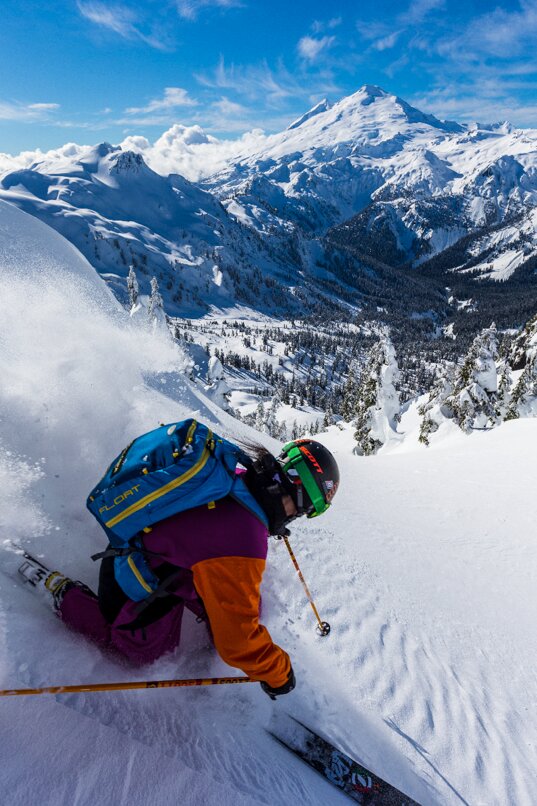 Staying Afloat
Staying AfloatPhoto by Grant Gunderson
It was February of 2012, and three skiers were dead just outside of the Stevens Pass Ski Area in the Tunnel Creek drainage. Five people were initially caught in the backcountry avalanche. One of the survivors became wedged between two trees while snow rushed over him.
The other survivor, Elyse Saugstad, deployed an avalanche airbag, which kept her near the surface of the snow and allowed rescuers to find her quickly. Along with other high-profile cases of airbag-assisted avalanche survival, Saugstad’s experience created a great deal of interest in avalanche air bags. Our shop at the American Alpine Institute (AAI) began to receive almost daily inquiries about these potentially lifesaving tools.
In essence an avalanche airbag is a regular backpack with one or more large airbags stowed in the top and the side. The idea is that if there is an avalanche, the skier can pull a ripcord and deploy the rapid inflation airbags. Then, in theory, these airbags will keep the skier’s body near the surface of a moving avalanche, allowing for an easier rescue.
There are many aspects that must be taken into account prior to the purchase of one of these systems. Before making any purchasing decisions, you must look at the advantages and disadvantages of three main aspects of this system.
What type of gas is being used to inflate the bag chamber?
How many airbags are being inflated, and how much volume?
What type of mechanism is being used to trigger the deployment of the airbag(s)?
To decide what kind of gas (compressed air or nitrogen) is the most appropriate for you, think about where you are going to use your pack. Air temperatures and altitude may have an effect on cartridge performance and the speed by which the gas moves from the cartridge to the airbag. It appears that compressed air works a little better at lower altitudes – like those found here in the PNW – while nitrogen works better up high.
One additional concern that should be mentioned is the difficulty some have had taking these backpacks abroad. For some reason the TSA doesn’t like weird cartridges of gas stashed inside backpacks on their planes...
The terrain that you’re skiing is another factor to take into account. If you’re skiing in a place where there are lots of sharp trees and branches, or in a place where there are a lot of sharp rocks, there is the possibility that you are going to puncture a balloon. Some systems employ a two-balloon pack with two valves, providing a back up in case a balloon is punctured or a valve malfunctions.
Some brands have worked hard to develop a configuration that provides more “floatability” by playing with the volume and spatial adjustability of the balloons.
If you are going to be using the pack as a recreationalist you may have different needs than a ski patroller or a guide. Why? Because each group has different needs. The recreationalist needs affordability and functionality with a simple pull. Professionals often use packs with mini-explosives that (according to the respective marketing departments) will guarantee deployment above and beyond the minimum standards. Lastly, a guide may want a remote control triggering mechanism in case one of his or her participants is in a slide, but fails to trigger their system.
Now the real trick of these packs is not that they might save you from an avalanche, it’s that they might trick you into a false sense of security. The pack will give you a better chance if you’re in a slide (an increase in survivability of about 16 percent for those caught in a serious avalanche, according to statistics compiled by the Utah Avalanche Center), but it won’t save you from drop-offs, trees, boulders or any number of other terrible things that could happen to you if you’re involved in a slide.
The best tool that you have to avoid an avalanche is your own brain and your ability to use it. If you haven’t taken an avalanche course, then you’re missing the key ingredient.
To learn more about the statistics surrounding avalanche air bags and balloon technology in the 2012-2013 season, please log onto utahavalanchecenter.org/blogavalanche-airbag-effectiveness-something-closer-truth.
The avalanche instructors and ski guides at AAI have all indicated a belief that these packs will be industry standard within the next few years. If you are a backcountry skier or snowboarder and you don’t have one of these yet, you might want to look into air bags and start saving up. X
Following is a list of Level I programs offered by AAI (alpineinstitute.com). The standard American Institute for Avalanche Research and Education (AIARE) Level I course provides a three-day curriculum with one full classroom day in Bellingham and two days in the Baker backcountry.
For those who can’t commit three consecutive days to a program, AAI offers a two-evening/two-day option in conjunction with the Outdoor Center at Western Washington University (WWU). Two evenings of lectures from 6 to 10 p.m. are followed by two days in the field. This option is open to the public, and WWU students receive a $50 discount.
Three-Day Level I Programs – $325
Nov 29 – Dec 1
Dec 6 – Dec 8
Dec 13 – Dec 15
Dec 28 – Dec 30
Jan 3 – Jan 5
Jan 10 – Jan 12
Jan 18 – Jan 20
Jan 24 – Jan 26
Feb 7 – Feb 9
Feb 15 – Feb 17
Feb 21 – Feb 23
Feb 28 – Mar 2
Mar 7 – Mar 9
Two Evenings/Two Days Option – $325
Evening Lectures: Jan 14, Jan 16
Field Days: Jan 19, Jan 20
Evening Lectures: Jan 28, Jan 30
Field Days: Feb 1, Feb 2
Evening Lectures: Feb 25, Feb 27
Field Days: Mar 1, Mar 2